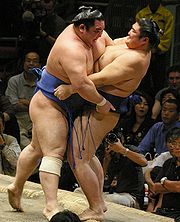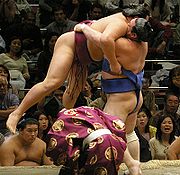
Wakanosato Shinobu
Encyclopedia
Wakanosato Shinobu is a professional sumo
wrestler from Hirosaki
, Aomori
, Japan
. He has been ranked mostly in the top division since 1998, and his highest rank has been sekiwake. He holds the record for the most consecutive tournaments ranked in the junior sanyaku ranks of sekiwake and komusubi (19 from 2002
until 2005
). He has won ten special prizes
and has twice been runner-up in a tournament.
. He met Takahanada (later the 64th yokozuna Takanohana) when a regional tour came to Hirozaki City, getting into the ring with him. He entered professional sumo in March 1992 after completing middle school, although he had been admitted to Hirosaki Jitsygyo High School. He had received offers from four or five different heya
upon his graduation, but the small and relatively new Naruto stable
appealed to him. Like many sumo wrestlers, he initially competed under his family name, Kogawa, but upon reaching the second highest jūryō division in November 1997 he was given the fighting name
of Wakanosato, reminiscent of his stablemaster, former yokozuna Takanosato.
 He entered the top makuuchi
He entered the top makuuchi
division for the first time in May 1998, but broke his ankle in a match with Musoyama in November 1998 and had to miss the following tournament. He suffered a more serious injury in November 1999, rupturing anterior cruciate ligament
s. He sat out two successive tournaments after having surgery and was demoted to the jūryō division . He won consecutive jūryō championships upon his comeback, in May and July 2000, and was promoted back to makuuchi in September. He quickly made the titled sanyaku ranks, making komusubi in November 2000 and recovering from 2-6 down to finish 9-6. As a result he was promoted to sekiwake for the first time in January 2001.
In his early top division career, Wakanosato was considered a promising candidate for ōzeki. From January 2002 until January 2005 he spent 19 consecutive tournaments ranked at either komusubi or sekiwake, an all time record. However, he was never able to break through the "great barrier" (the literal meaning of ōzeki), just failing to attain the necessary 33 wins over three tournaments. He was runner-up in the January 2003 tournament, and again in September 2003, where his 11-4 score was probably his best chance to make ozeki. However, he could only manage seven wins in the following tournament. He was never able to consistently beat the top ranked wrestlers, being unable to beat Takanohana in nine attempts and winning only five times out of 32 meetings against ozeki Chiyotaikai. Nevertheless he has been awarded ten sansho
or special prizes for good performances in tournaments during his career.
In more recent years Wakanosato has again suffered from injury problems, being forced to withdraw from his final (to date) sanyaku-ranked tournament in September 2005 and missing all of the next. He was also forced to sit out all of the September 2006
tournament and fell to the second division once again. However, he made something of a comeback in May 2007
, turning in a strong 10-5 record at maegashira 7. He won his 600th career bout in September 2007, and turned in another good performance in May 2008
, again finishing on 10-5.
 He withdrew from the March 2009
He withdrew from the March 2009
tournament after breaking a metatarsal bone in his right foot during his 11th day bout with Kotoshogiku. He had surgery on 8 April which put him out of action for at least two months, meaning he had to sit out the following tournament in May. He came back very strongly in July, winning his fourth jūryō championship with a 14-1 record. He reached Maegashira 1 in March 2010, his highest rank in over four years. After that he comfortably maintained a position in the mid-to-upper maegashira ranks until he was injured in the November 2011 tournament, which will mean yet another fall to juryo.
that involve grabbing hold of the opponent's mawashi
. He is known as being particularly difficult to beat once he has got a migi-yotsu, or right hand inside, left hand outside grip. About 40 percent of his wins are by yori kiri, or force out, but he is also good at pushing and thrusting, winning many bouts by oshi-dashi or push out. His two most commonly used throws are sukuinage (scoop throw) and uwatenage (overarm throw).
Sumo
is a competitive full-contact sport where a wrestler attempts to force another wrestler out of a circular ring or to touch the ground with anything other than the soles of the feet. The sport originated in Japan, the only country where it is practiced professionally...
wrestler from Hirosaki
Hirosaki, Aomori
is a city located in southwest Aomori Prefecture, Japan. It is a castle town and was the Tsugaru clan ruled the 100,000 koku tozama han Hirosaki Domain from Hirosaki Castle during the Edo period. The city is currently a regional commercial center and the largest producer of apples in Japan...
, Aomori
Aomori Prefecture
is a prefecture of Japan located in the Tōhoku Region. The capital is the city of Aomori.- History :Until the Meiji Restoration, the area of Aomori prefecture was known as Mutsu Province....
, Japan
Japan
Japan is an island nation in East Asia. Located in the Pacific Ocean, it lies to the east of the Sea of Japan, China, North Korea, South Korea and Russia, stretching from the Sea of Okhotsk in the north to the East China Sea and Taiwan in the south...
. He has been ranked mostly in the top division since 1998, and his highest rank has been sekiwake. He holds the record for the most consecutive tournaments ranked in the junior sanyaku ranks of sekiwake and komusubi (19 from 2002
2002 in sumo
-Tournaments:*Hatsu basho, Ryogoku Kokugikan, Tokyo, 13 January - 27 January*Haru basho, Osaka Prefectural Gymnasium, Osaka, 10 March - 24 March*Natsu basho, Ryogoku Kokugikan, Tokyo, 12 May - 26 May...
until 2005
2005 in sumo
-Tournaments:*Hatsu basho, Ryogoku Kokugikan, Tokyo, 9 - 23 January*Haru basho, Osaka Prefectural Gymnasium, Osaka, 13 - 27 March*Natsu basho, Ryogoku Kokugikan, Tokyo, 8 - 22 May*Nagoya basho, Aichi Prefectural Gymnasium, Nagoya, 10 - 24 July...
). He has won ten special prizes
Sansho (Sumo)
Sanshō are the three special prizes awarded to top division sumo wrestlers for exceptional performance during a sumo honbasho or tournament. The prizes were first awarded in November 1947.-Criteria:...
and has twice been runner-up in a tournament.
Career
He first tried sumo in the third grade when he entered a competition for fourth graders and up and came in third. By middle school he was training every day at a sumo dojoDojo
A is a Japanese term which literally means "place of the way". Initially, dōjōs were adjunct to temples. The term can refer to a formal training place for any of the Japanese do arts but typically it is considered the formal gathering place for students of any Japanese martial arts style to...
. He met Takahanada (later the 64th yokozuna Takanohana) when a regional tour came to Hirozaki City, getting into the ring with him. He entered professional sumo in March 1992 after completing middle school, although he had been admitted to Hirosaki Jitsygyo High School. He had received offers from four or five different heya
Heya
In sumo wrestling, a heya , usually translated into English as stable, is an organization of sumo wrestlers where they train and live. All wrestlers in professional sumo must belong to one. There are currently 49 heya , all but four of which belong to one of five ichimon...
upon his graduation, but the small and relatively new Naruto stable
Naruto stable
is a stable of sumo wrestlers, one of the Nishonoseki group of stables.The stable was established on 1 February 1989 by former yokozuna Takanosato Toshihide. The stable's first sekitori was Rikio in 1994. Three more, Wakanosato, Takanowaka and Kisenosato, have reached sekiwake rank...
appealed to him. Like many sumo wrestlers, he initially competed under his family name, Kogawa, but upon reaching the second highest jūryō division in November 1997 he was given the fighting name
Shikona
A shikona is a sumo wrestler's ring name.As with standard Japanese names, a shikona consists of a 'surname' and a 'given' name, and the full name is written surname first. However, the given name is rarely used outside formal or ceremonial occasions. Thus, the former yokozuna Asashōryū Akinori is...
of Wakanosato, reminiscent of his stablemaster, former yokozuna Takanosato.

Makuuchi
or is the top division of professional sumo. Its size is fixed at 42 wrestlers , ordered into five ranks according to their ability as defined by their performance in previous tournaments....
division for the first time in May 1998, but broke his ankle in a match with Musoyama in November 1998 and had to miss the following tournament. He suffered a more serious injury in November 1999, rupturing anterior cruciate ligament
Anterior cruciate ligament
The anterior cruciate ligament is a cruciate ligament which is one of the four major ligaments of the human knee. In the quadruped stifle , based on its anatomical position, it is referred to as the cranial cruciate ligament.The ACL originates from deep within the notch of the distal femur...
s. He sat out two successive tournaments after having surgery and was demoted to the jūryō division . He won consecutive jūryō championships upon his comeback, in May and July 2000, and was promoted back to makuuchi in September. He quickly made the titled sanyaku ranks, making komusubi in November 2000 and recovering from 2-6 down to finish 9-6. As a result he was promoted to sekiwake for the first time in January 2001.
In his early top division career, Wakanosato was considered a promising candidate for ōzeki. From January 2002 until January 2005 he spent 19 consecutive tournaments ranked at either komusubi or sekiwake, an all time record. However, he was never able to break through the "great barrier" (the literal meaning of ōzeki), just failing to attain the necessary 33 wins over three tournaments. He was runner-up in the January 2003 tournament, and again in September 2003, where his 11-4 score was probably his best chance to make ozeki. However, he could only manage seven wins in the following tournament. He was never able to consistently beat the top ranked wrestlers, being unable to beat Takanohana in nine attempts and winning only five times out of 32 meetings against ozeki Chiyotaikai. Nevertheless he has been awarded ten sansho
Sansho (Sumo)
Sanshō are the three special prizes awarded to top division sumo wrestlers for exceptional performance during a sumo honbasho or tournament. The prizes were first awarded in November 1947.-Criteria:...
or special prizes for good performances in tournaments during his career.
In more recent years Wakanosato has again suffered from injury problems, being forced to withdraw from his final (to date) sanyaku-ranked tournament in September 2005 and missing all of the next. He was also forced to sit out all of the September 2006
2006 in sumo
-Tournaments:*Hatsu basho, Ryogoku Kokugikan, Tokyo, 8 - 22 January*Haru basho, Osaka Prefectural Gymnasium, Osaka, 12 - 26 March*Natsu basho, Ryogoku Kokugikan, Tokyo, 10 - 27 May*Nagoya basho, Aichi Prefectural Gymnasium, Nagoya, 9 - 23 July...
tournament and fell to the second division once again. However, he made something of a comeback in May 2007
2007 in sumo
-Tournaments:*Hatsu basho, Ryogoku Kokugikan, Tokyo, 7 - 21 January*Haru basho, Osaka Prefectural Gymnasium, Osaka, 11 - 25 March*Natsu basho, Ryogoku Kokugikan, Tokyo, 13 - 27 May*Nagoya basho, Aichi Prefectural Gymnasium, Nagoya, 8 - 22 July...
, turning in a strong 10-5 record at maegashira 7. He won his 600th career bout in September 2007, and turned in another good performance in May 2008
2008 in sumo
-Tournaments:*Hatsu basho, Ryogoku Kokugikan, Tokyo, 13 January - 27 January*Haru basho, Osaka Prefectural Gymnasium, Osaka, 9 March - 23 March*Natsu basho, Ryogoku Kokugikan, Tokyo, 11 May - 25 May...
, again finishing on 10-5.

2009 in sumo
-Tournaments:*Hatsu basho, Ryogoku Kokugikan, Tokyo, 11 January - 25 January*Haru basho, Osaka Prefectural Gymnasium, Osaka, 15 March - 29 March*Natsu basho, Ryogoku Kokugikan, Tokyo, 10 May - 24 May...
tournament after breaking a metatarsal bone in his right foot during his 11th day bout with Kotoshogiku. He had surgery on 8 April which put him out of action for at least two months, meaning he had to sit out the following tournament in May. He came back very strongly in July, winning his fourth jūryō championship with a 14-1 record. He reached Maegashira 1 in March 2010, his highest rank in over four years. After that he comfortably maintained a position in the mid-to-upper maegashira ranks until he was injured in the November 2011 tournament, which will mean yet another fall to juryo.
Fighting style
Wakanosato specialises in yotsu-sumo, or techniquesKimarite
Kimarite are winning techniques in a sumo bout. For each bout in a Grand Sumo tournament , a sumo referee, or gyoji, will decide and announce the type of kimarite used by the winner...
that involve grabbing hold of the opponent's mawashi
Mawashi
In sumo, a mawashi is the belt that the rikishi wears during training or in competition. Upper ranked professional wrestlers wear a keshō-mawashi as part of the ring entry ceremony or dohyo-iri.-Mawashi:...
. He is known as being particularly difficult to beat once he has got a migi-yotsu, or right hand inside, left hand outside grip. About 40 percent of his wins are by yori kiri, or force out, but he is also good at pushing and thrusting, winning many bouts by oshi-dashi or push out. His two most commonly used throws are sukuinage (scoop throw) and uwatenage (overarm throw).
Trivia
Wakanosato initially had an excellent head-to-head record against Hakuho, defeating him the first six times they met. However, the last of these victories came in 2005 and since then he has lost eleven in a row against him. Nevertheless, only Harumafuji, with nine, and Kotooshu and Kisenosato, with seven, have more wins over the yokozuna amongst active wrestlers.Jūryō and makuuchi record
See also
- Glossary of sumo termsGlossary of sumo termsThe following words are terms used in sumo wrestling in Japan. azukari : Hold. A kind of draw. After a mono-ii, the gyōji or the shimpan "holds" the result if it was too close to call...
- List of sumo tournament second division winners
- List of active sumo wrestlers

